SLIDES
PDM 2019.20
1 if there are building cultures around the world that had to learn to deal and cope with enormous and recurrent amounts of construction waste, those cultures can be found in seismic-areas.

Project site, San Pellegrino IT, 2019.
This assumption is not as linear as it could seem at first. However, building cultures do respond (to a certain extent) to natural phenomena: among these, earthquakes are the only ones which force inhabitants to consider building recycling and rubble disposal not as accessory features but as basic survival needs.















Earthquakes (with conflicts) are the only contemporary situation, at
least in the western world, where population has to face from one day to the
next not only an important number of human losses, but also the problem of
dealing with tremendous amount of waste, debris and rubble.
Hence, buildings in
seismic areas offer the best conditions to put at test a series of operational
and constructive principles that, to a certain extent, all the buildings should
now-a-days possess. The constant need of these areas to the necessity of coping
with building waste and frequent repairs is the starting point of the Diploma
project.
︎Plan

2 On 24 August 2016 Central Italy was hit by an earthquake measuring 6.2 on the magnitude scale. In less than twenty seconds, entire villages and towns were torn down into rubble.

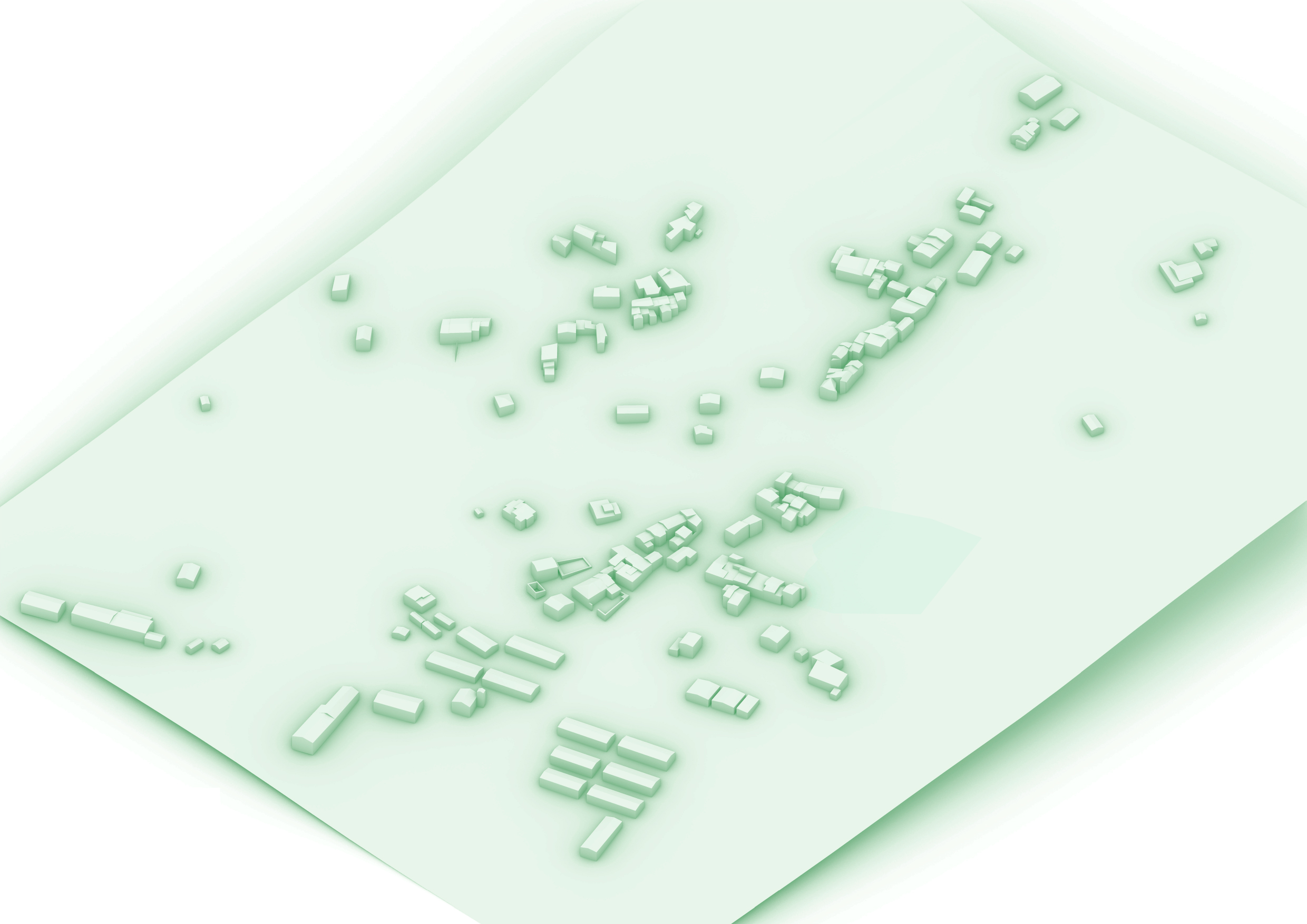
Less than one year later,
on 18 January the same area was hit by a second series of seismic events with a
peak magnitude of 6.5. This time all the villages surrounding the major town of Norcia suffered, for most part,
irreparable damages.
![]()
The damage assessment resumes the post-seism analysis of
government engineers in 2016 and 2017, a drone analysis by the firefighter
department and a personal analysis made in situ. The rest of the building stock
analysis provides an idea of the situation ante-seism.
Project site, San Pellegrino IT, 2019.
3 DTLC technology traditionally demands for quite restrictive constraints in terms of plan shape.
A square or rectangle plan or
any shape where the center of mass and the shear center are coincident. Plus,
vertical diaphragms are fundamental for the stability of the building, but
their proximity oblige to compose a plan with small room dimensions (max. 6m
wide). In order to introduce a differentiation of rooms already at this
preliminary stage, an offset of the major diaphragms axes is introduced. This
results in a sound and compact plan for DTLC appliance and at the same time, 6
rooms different in surface amount, dimensions and orientation.

Traditional Nepali DTLC, Build Back Better, 2007
4 the Norcia region has always been constantly interested by a consistent seismic activity. In the past, even stronger and more destructive earthquakes struck the region.

demographic trend and earthquakes timeline in San Pellegrino
Nonetheless, the population never abandoned this area. Institutions and governments always managed to rebuild the economic fabric because this valley has always been a pivoting zone for meat production but more importantly meat products elaboration. Now-a-days in this region, as in several other rural areas in Europe, the population is in decline. An earthquake is hardly the only cause of demographic drop.
5 "delocalization" projects are never an easy task for authorities. They must deal with a highly fluctuant, not stable number of housing receivers; nor for the local population which not only has to face the trauma of earthquake damages but also the one given by moving away from their original (yet irremediably damaged) homes.
 floating program
floating programThe information to build a housing program result incomplete, imprecise and more than ever dynamic, therefore the housing program is only indicating the housing typologies. The possibility for the plan to change its layout and apartment composition in time may be considered as a valid answer to the precarious situation. In fact, the housing layout (number and typology) should be adapted to the last-minute change before and during construction and, eventually in the future. The latest data seems to confirm 156 residents in the area of San Pellegrino, organized as illustrated.
6 the main characteristic of the master plan, beside most classical features such as the creation of a public space, connecting the two sides of the residential area, is the artificial topography.

masterplan
The artificial sidehills allows to introduce privacy for R0 storey, they build a natural draining system towards the valley and under a strict urban perspective they allow to build a landscape which do not alter the rural and agrestic character of the village.
7
![]()
potential for a possible regeneration around a new town center8,43 the village was mainly built in stone (for the majority limestone) masonry. Despite multiple cleaning operations by authorities, the village is still facing the problem of debris obstruction in most of the area.

San Pellegrino, 2016
Being the closest recycling center more than 11 km away from
the village, the villagers are facing extra charges to dispose the debris. In
addition, only demolitions of damaged houses facing public roads are taken in
charge by the government.
![]()
![]() This situation has jeopardized the demolition and
reconstruction of old houses for more than 2 years. 400 demolitions have been
carried by authorities and more than 100.000 tons of debris are now stocked in
a temporary facility (to compare this number, in Vaud the amount of mineral debris originated by the building sector, without taking in account excavations, is 1.25 m of tons). The main task of the project is to absorb and up-cycle in situ the majority of damaged houses
and their demolition wastes.
This situation has jeopardized the demolition and
reconstruction of old houses for more than 2 years. 400 demolitions have been
carried by authorities and more than 100.000 tons of debris are now stocked in
a temporary facility (to compare this number, in Vaud the amount of mineral debris originated by the building sector, without taking in account excavations, is 1.25 m of tons). The main task of the project is to absorb and up-cycle in situ the majority of damaged houses
and their demolition wastes.



temporary recycle center of Misciano (IT).
9 In winter, the distance between buildings allows the south oriented facade to be hit by sun rays (for solar gaining); on the other hand, in summer, the layout offers shaded, thus cooler area in-between the smaller buildings sides.

solar overview of the housing complex
10 the oldest village branch, located north, is the one which suffered the most from the two earthquakes. The two other branches suffered heavy damages which would most probably require a total demolition of the remaining buildings.

11 the model building for the housing complex is a two-story house with a lobby, a staircase column and 13 rooms.

generic plan description
The interior and exterior stairs lead to the lobby, they are detached from the main structure in order to adjust and cope with cumulated tolerances during the building phase of the main masonry walls. The exterior sidehills allows to introduce an extra level or intimacy for ground floor apartments, they also provide a safety distance between the main exterior circulation and the house perimeter in the event of debris fall during an earthquake. The cross corners and the overextended wall offer an extra balcony house and protection of the exposed timber within the exterior wall leaves. The balconies cover also the function of sun barrier to avoid overheating in summer (esp. south oriented facade), all by letting winter rays reaching the wall in colder times. Finally, all openings, in every wall are placed on the same vertical and horizontal axe for anti-seismic reasons.
12 Most of the old building stock and private parcels will exchanged by authorities with new ones in a delocalized village site. Special urban rules have also been enacted for the occasion.

The only two typologies possible are the "schiera" (rowhouse, point C: hosing type I) and the second is the "villetta" typology (independent villa, point C: housing type II). The housing typology chosen for the project is a hybrid between these two imposed categories.
13-21,28


DTLC formal limitations (small rooms, opaque walls, door and openings placed in the mirror axe of any element) and seismic constraints (rectangular plan, convex corners, uniform shape and homogenous distribution of vertical diaphragms and interior partitions) produce a plan which leave very little room for housing diversification.
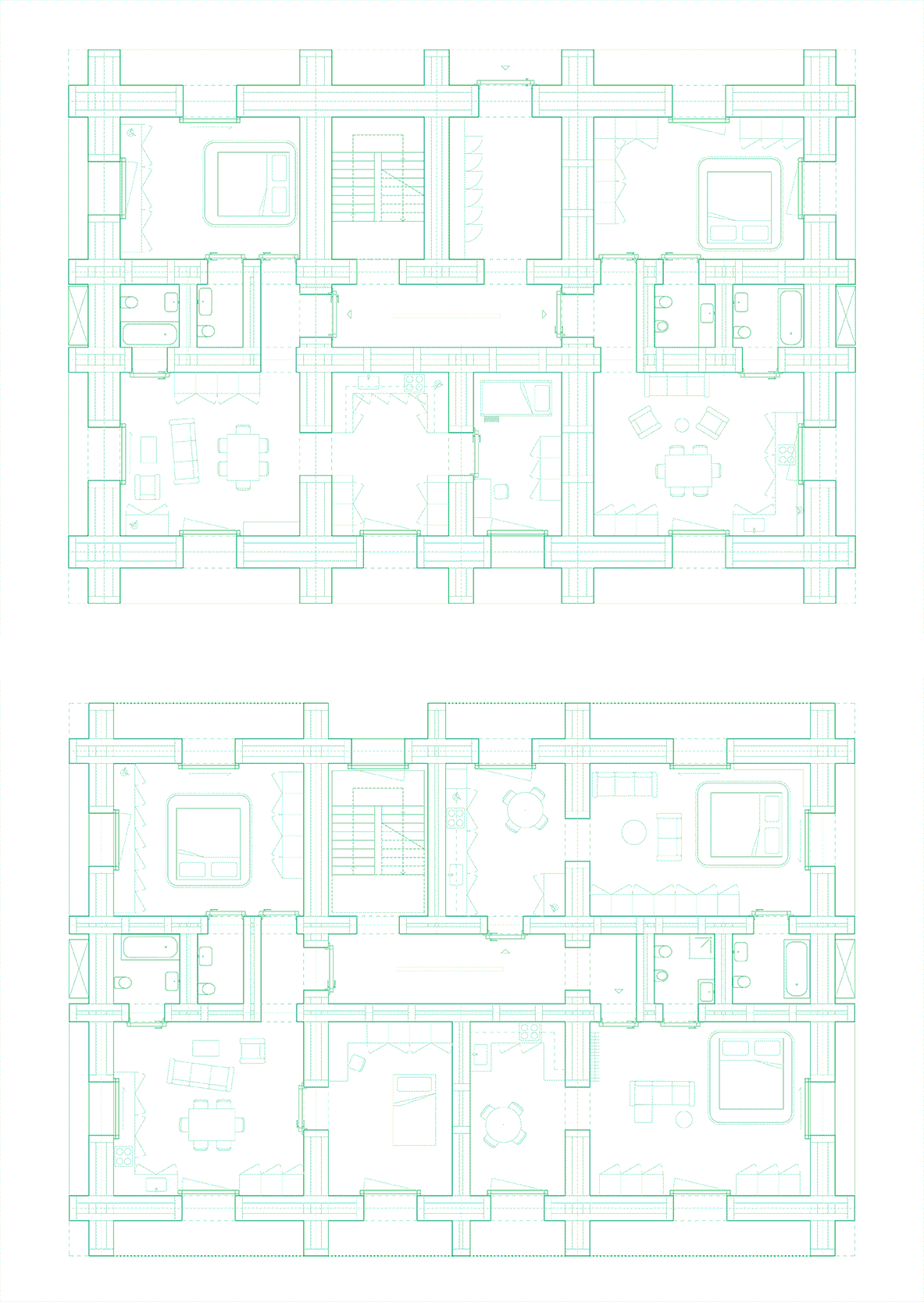
R0, R1 apartment combinations
Nonetheless such generic
plan, which could be defined as "enfilade" (a sequence of linked and
consequent rooms) has the chance to be easily changed.


Genericity, in this
case, has proved to be a durable quality for the plan since it allows changes
of the apartment composition without altering the major structure of the
building: opening or filling up the middle wall opening is enough to create a
network of different apartments, hence housing layouts.

la casa rurale nell’alta Valnerina. Mario Fondi e Athos Poeta. 1955
Therefore, typologies range can span from a full studios block to a "villa" typology in which all the rooms are linked and belonging to a unique housing unit, a full plan en enfliade.

2 rooms apartment view


22-24
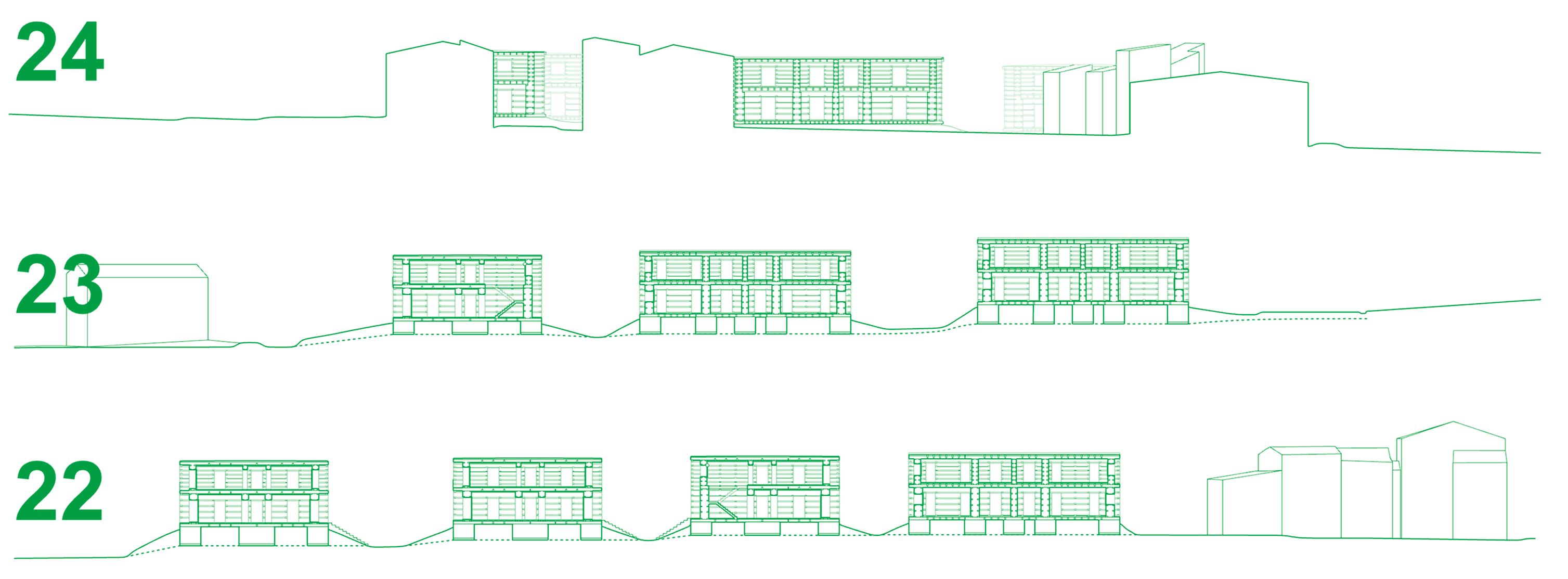
25 the delocalization area for the new residential complex has been chosen based on hydro-geological analysis of the terrain. In fact, part of the old village is affected by erosion phenomena, hence the ground is highly instable, and dump rises from the humid alluvial soil. The designated area is a surface of app. 8600 sqm previously occupied by 5 distinct wheat fields.
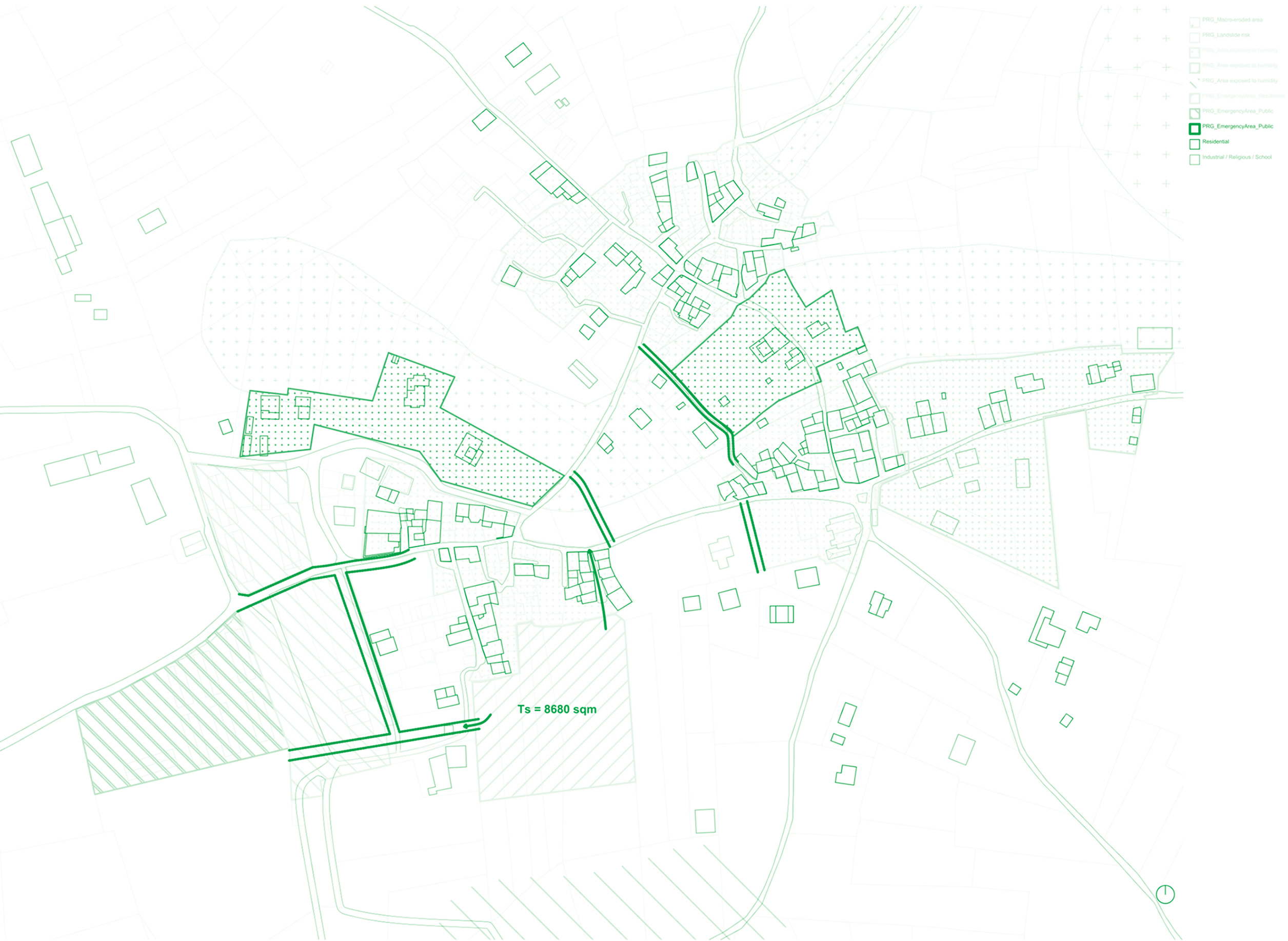
26 San Pellegrino is a small village located in the Appennini chain mountain in central Italy (alt. 800m), it belongs to the municipality of Norcia, in the province of Perugia, in the Umbrian region. It faces the valley of Norcia and its many cultivation fields. The masterplan tends to take in account the view towards the valley as a preferential orientation for the new housing stock.

︎Cross-section

27 in order to ballast the very light (due to seismic restrictions) roof's connections on top of the walls, a pile of stacked rocks is placed above the wall top head.

Once again, the absence of cement has
the advantage of not retaining any water within the pile. Hence it lets the
raining roof water drain towards the gutter.

29 one of the best advantages of using cement has always been of building plumbed high wall, fast and without any high skilled labor. In exchange to a laborious and time-consuming assembly, and thanks to the containments created by the timber ladders, DTLC building system can achieve the same result of its cement-based version by restarting the wall starting level each time a new containment is created.

30 if exterior walls are conceived to be air-tight, inner walls and punctual spot within the perimetral walls can become air-permeable thanks to a looser stone layout. This would allow a natural ventilation of the house without need for AC. Nevertheless, the most immediate application is related to wet rooms: used air can be channeled through the last layer of the wall and rechanged by fresh cooler air from close rooms.

dry masonry and natural ventilation
31,46 As in old stone houses, DTLC spaces perform extremely well during summer by reducing and buffering the exterior hot temperatures, on the other hand, during winter, the north oriented side of the house can be very cold.

The project aims and propose to reconsider cloths, and out-of-date thermic devices such as the baldaquin like renewed protections against cold interior climate. Since most of the time spent in a bedroom is during the night, the project couple the use of a local radiator with a baldaquin which can then create a thermic comfortable bubble especially during the night.



The house
will not be uniformly heated. The heated space will be limited to the south
side: less heat demand thanks to thermal mass of the walls. They also represent
the spots where we can find the most frequented spaces during day time, here,
contrary to the bedroom, we do not possess any other low-tech thermal devices
to protect ourselves against cold interior temperatures but a punctual heated
floor.
![]()
The project wants to introduce a way of living conscious of the incoming
degrowth and the consequent limitation of resources that this phase would mean
for the general housing comfort: the strategy is to frame the inevitable loss
of energy available by simplifying the wall composition, profiting of solar gains
and re-introducing low-tech thermal devices which would eventually redefine the
way we use our buildings.
all the building equipment (water, electricity, etc'...), due to the nature of the dry stacked wall, need to be embedded in and passing through the floor. Whenever a connection is needed this will be always visible, thus easier to be repaired. As for the sleeping area, principles of selective comfort are also applied here through the device of a heating plate. This plate placed in the proximity of the openings (to profit from solar gains) can be switched on, if needed, at given time of the day to reach an adequate and comfortable temperature for the users.
32 DTLC has no insulation within its wall composition. This implies a different thermal strategy to the one normally employed in insulated building. Few wall compositions were studied but adding an insulation layer (or timber) jeopardizes the solar gains acquired by the thermal mass. The project decides to leave the DTLC wall as it is in traditional construction. For this reason, in order to obtain a reasonable thermal comfort, few notes on the way one might use this building must be noted (pt.31).

33,37
each room's slab is independent from the other
pieces of the building. The surroundings walls of each slab are all charged
thanks to the connection of the central frame with each room’s perimetral
beams. This redundancy in connections and components is at the core of the
durable qualities of this system: each slab's elements can be replaced
independently and easily from the inside.
![]()
although the timber slab's joinery is fairly
simple (screws, brackets and T aluminum plates).This redundancy in connections
and components is at the core of the durable qualities of this particular
system: each slab's elements can be replaced independently and easily from the
inside. Furthermore, the slab is braced by small transversal joists and OSB
panels on top which reinforce their bracing capability under dynamic charges.

34 DTLC can be defined as a stacking system. The absence of timber vertical elements may allow the building to settle uniformly and in order to avoid any other differential settling the whole building should be conceived as a platform system: each floor’s slabs lay on top of walls letting them to take up the majority of normal charges, there is seizure in the wall charge transfer from bottom up.

Furthermore, due to the absence of mortar,
ground floor and upper floors have different wall thicknesses, as well as the
interior walls are generally less thick then boundary walls, the floor heights
are subjected to the same hierarchization: ground floor has a bigger interior
height than the upper floor.



35 recycled and irregular timber elements can be employed as ladders. The continuity of timber belts allows to strap the building on in case of dynamic charges.

Corners are simply overlapped and secured by screws, transversal pieces reinforce the ladders stability, and their top heads are chamfered for safety and draining water away. The image shows the simplest version of the ladder layer: over-lapped, staggered lintels without complex timber joinery. As it often happens galvanized steel screws can be employed to secure the overlapping lintels, nonetheless it would be interesting to consider hardwood peg to stiffen these intersections.
36 The project follows, for the most part, the optimal present-day application of the dry timber lace technique recommended by a study held by the Swiss Agency for Development and Cooperationand the French Red Cross coordinated by Tom Schaher (2007). Old versions can differ and present multiple variations on the same principles here listed. DTLC, Dry Timber Lace Construction is a dry half-timber stacking construction system. Foundations are typically made of stones. Ladders run through the entire perimeter and they have two functions: to plumb the wall and strap the building on in case of earthquake. All the timber elements sections are around 7.5/10 cm.

All the timber elements sections are around 7.5/10 cm. For timber belts, transversal connectors’s strong axe is horizontally placed, whereas beams and tie-beams's strong axe is (as usual) vertically positioned. Long span beams are considered not only dangerously heavy, but also expensive and complex to assemble, transport on site and repair. All the corners are overlapped and secured by simple screws. The joists top heads are placed at least 10 cm away from the wall to preserve them from any moisture damage, a simple cogged lap joint between the ladders and the joists can further fasten the solidity of the slab.


38 the artificial topography which surrounds every building help to drain the water away from the dry-masonry foundations. The water is channeled and drained towards the street and later towards the valley. This last draining device is composed by denser layers of recycled gravel, whereas the lateral rampart can be realized out of gravel and excavation earth.
39 the interstitial space between foundations can be employed to recycle and put at use to use part of the mineral debris (concrete, brick and all type of mineral debris). Giving the considerable height of foundations, it would be possible to dispose of much of the demolished debris at least for the life span of the building.
40 DTLC (dry timber lace construction) offers the advantage of not using cement, which requires important quantities of energy and water for its fabrication. The fact of not having any mortar AND using irregular elements “as found” (untrimmed, unprocessed) poses the capital problem of airtightness. By using small granulometries within the core of the wall may assure some level of airtightness, nevertheless further study is required to prove the validity of this point; nevertheless, this strategy has the potential to put at use a much wider range of debris granulometry instead of a normal wall.

41 the roof, whenever the climate would allow, is preferably built flat due to the dangerous lateral stress that a trussed roof could exercise on the masonry, especially in the event of an earthquake. In order to keep the roof as light as possible, there is no thermal mass or heavy tiling which come on top of the roof: its composition is limited by a OSB paneling (to brace the roof) and a film for water tightness.
︎Visuals

42 the general masterplan for the housing project would like to make echo to the local rural landscape. By limiting as much as possible common urban/city treatment for exteriors, the artificial topography alone should provide the housing complex exteriors with a familiar yet rural and rough landscape.

valnerina landscape I, 2019
valnerina landscape II, 2019
44 all the stairs are conceived as light structures assembled on site once the masonry is built. This will allow to catch up with the numerous intolerances cumulated during the stacking building process of the dry-masonry. Plus, the inner stairs are the only vertical element present in the building system, hence a solid connection to the masonry system would be detrimental to the settling process of the walls. Being detached from them, the stairs can independently adapt to the slow but inevitable settling (tassement) of the masonry.

45 floors are realized with a terrazzo technique (plus a floating floor to avoid cracks from the masonry settling). Among many other flooring techniques this is the one that lets up-cycling some of the mineral debris of the village. Here a view of the lobby.

46 all the building equipment (water, electricity, etc'...), due to the nature of the dry stacked wall, need to be embedded in and passing through the floor. Whenever a connection is needed this will be always visible, thus easier to be repaired.

the smallest and most privative street mainly function as circulation and it’s reserved to close activities to the apartments (e.g. children playing).

48 a path which connects the two sides of the ilôt. Being the second largest street, it connects the two sides of the housing complex.

49 mainly providing shading during summer, they also allow lateral access from the parking lots.

50 the main connexon to what it’s left of the old village. This is also the largest communication segment of the residential complex. Waiting for a possible urban regeneration of the old village, ruins can be whitewashed and integrated in the housing surroundings as a temporary, yet framed and visually integrated landscape.

︎Axo

51 as it often happens for stacking processes, a temporary shelter for the building site is almost mandator. This is the occasion to integrate to the scaffolding structure a gantry-like system for the robotic assembly: by doing so, 4 or more hanging robots can move at the same time in the 3 dimensions within the sheltered space, picking rocks or timber elements and attaint every spot of the plan. In addition to that, a temporary shelter allows the robots to be protected from weathering and in case of nocturnal shifts, to be protected. Due to the fact that the stones need to be stacked uniformly from the first layer until the last one, the gantry system permit a total control on tolerances over the stacking process since every floor wall is built without seizure. The building's tolerances can be constantly monitored and adjusted if needed during the construction: by modifying the height of each stone containments or by changing the thickness of the timber layer. In the illustrated version there are 4 different portals corresponding to 4 different hanging robot-arm in order to speed up the stacking process.
52 alternative options offer a less invasive and more economical alternative to the gantry-scaffolded system presented in the main project. Here a mobile robot-arm can be employed for foundation building. A mobile shelf system can be coupled to enhance the stone pool refilling during the assembly phase
53 alternative options offer a less invasive and more economical alternative to the gantry-scaffolded system presented in the main project. Here, a turret mobile robot can follow the construction of an entire wall from bottom-up. The stone and timber pool will be limited but the robot can still move forward and backward to reach a larger pool area.

54 DTLC is an extremely time-consuming technique which not only requires a high level of precision during the assembly, but it also demands for a constant refill of stones and timber. Within the perspective of a partial automatized construction, robots can compensate the long assembly time by working also during night shifts. In fact, while the hanging robot arms are in function no contractor can refill the floors with new stones. Meanwhile, during daylight, contractors could recycle and process debris in order to refill later the stone pools. Every day one layer will be completed. The sourcing of materials and the building construction would happen at the same time.

55 one of the requirements for robotic DTLC assembly is the necessity for the machinery to reach and have a wide pool of possible stone combinations. Multiple stone dimensions must be simultaneously accessible for the robot arm. In order to avoid any extra infrastructure, the system wants to take advantage of floor surfaces during the construction phase. Each time the floors can be recharged manually, and the robot-arm can carry out one stacking loop until all the debris have been employed. RGB-D cameras can monitor and inform if a particular debris size is missing for the completion of one wall layer.

56 the gantry system's scaffoldings are limited to one store. In fact, working with smaller scaffolds elements might represent an easier and more comfortable, although more time consuming, alternative for un-trained workers. The scaffold makes use of the overhanging timber beams as in traditional construction: balconies can serve as support for the scaffold during the construction phase, especially in regard to upper floors. Once the assembly of the first level is over, the gantry system and scaffoldings are disassembled and re-assembled on top of the completed floor.
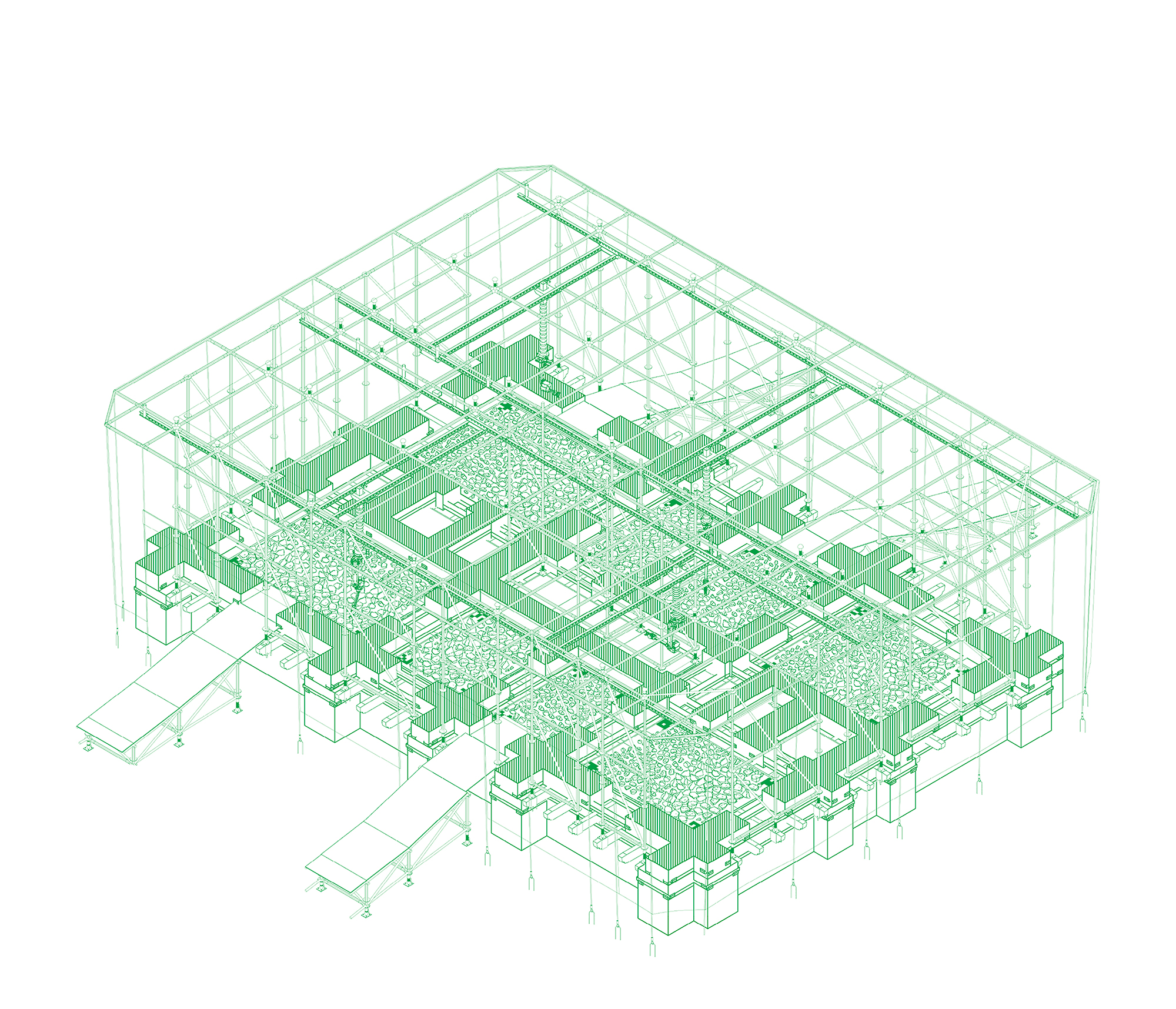


57,58 The Air Flow Resistance is directly linked to the size and the layout of the debris employed. Smaller debris may generate smaller joints and more turbulences which diminish the air flow through the wall. On the other hand, in order to use the largest variety of granulometry, a degradation between zones is recommended (pt.40). The type of granulometry depends of which thermal/comfort quality we aim for the project.

For example, a non-heated space should be air-tight to avoid ventilation heat loss, but a non-heated space such as a cave or a humid storage could require more ventilation (and so bigger granulometries). On the other hand, most of housing pieces should be air-tight, but it could be possible to imagine area of the house naturally ventilated to avoid any AC systems (a jardin d'hiver, loggias or dump rooms e.g. pt.30).

Following the previous granulometry graph for our designed wall, it’s time to collect an approximated number and corresponding granulometry of debris/stones (by also taking in account a 10%/15% more of debris) This isn't an exact analysis of which stone are needed, but more of an approximation of the amount and the type (granulometry) of stones to be collected. This flexibility and growing precision of the collecting process is helping in adapting the material sourcing and the design process to raw and irregular sourcing of materials.

all operations to perform directly in the collection site (quarry or recycling center).
59 during the first emergency phase, immediately after the first earthquake, the area 1 was levelled and partially covered in concrete in order to allocate emergency structures and housing. During the reconstruction this area can be reconverted to a temporary storage area to process the debris coming from the 3 branches of the village.







